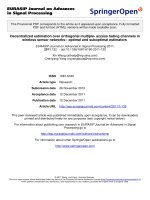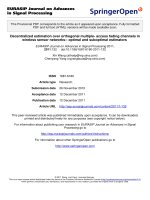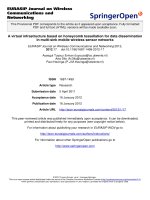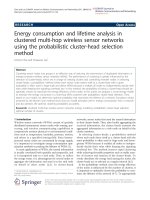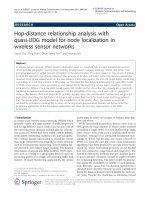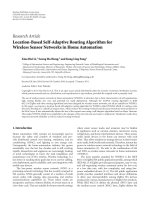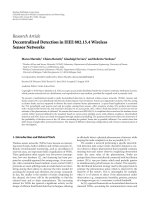..Wireless Sensor Networks.IAN F. AKYILDIZ SERIES IN COMMUNICATIONS AND NETWORKING Series Editor: docx
Bạn đang xem bản rút gọn của tài liệu. Xem và tải ngay bản đầy đủ của tài liệu tại đây (12.94 MB, 518 trang )
Wireless Sensor Networks
IAN F. AKYILDIZ SERIES IN COMMUNICATIONS AND NETWORKING
Series Editor: Ian F. Akyildiz, Georgia Institute of Technology, USA
Advisory Board: Tony Acampora, UC San Diego, USA
Hamid Aghvami, King’s College London, United Kingdom
Jon Crowcroft, University of Cambridge, United Kingdom
Luigi Fratta, Politecnico di Milano, Italy
Nikil Jayant, Georgia Institute of Technology, USA
Leonard Kleinrock, UCLA, USA
Simon S. Lam, University of Texas at Austin, USA
Byeong Gi Lee, Seoul National University, South Korea
Yi-Bing Lin, National Chiao Tung University, Taiwan
Jon W. Mark, University of Waterloo, Canada
Petri Mähönen, RWTH Aachen University, Germany
H. Vincent Poor, Princeton University, USA
Guy Pujolle, University of Paris VI, France
Krishan Sabnani, Alcatel-Lucent, Bell Laboratories, USA
Stephen Weinstein, Commun. Theory & Tech. Consulting, USA
The Ian F. Akyildiz Series in Communications and Networking offers a comprehensive range
of graduate-level text books for use on the major graduate programmes in communications
engineering and networking throughout Europe, the USA and Asia. The series provides
technically detailed books covering cutting-edge research and new developments in wireless
and mobile communications, and networking. Each book in the series contains supporting
material for teaching/learning purposes (such as exercises, problems and solutions, objectives
and summaries etc), and is accompanied by a website offering further information such as
slides, teaching manuals and further reading.
Titles in the series:
Akyildiz and Wang: Wireless Mesh Networks, 978-0470-03256-5, January 2009
Akyildiz and Vuran: Wireless Sensor Networks, 978-0470-03601-3, August 2010
Akyildiz, Lee and Chowdhury: Cognitive Radio Networks, 978-0470-68852-6
(forthcoming, 2011)
Ekici: Mobile Ad Hoc Networks, 978-0470-68193-0 (forthcoming, 2011)
Wireless Sensor Networks
Ian F. Akyildiz
Georgia Institute of Technology, USA
Mehmet Can Vuran
University of Nebraska-Lincoln, USA
A
J
ohn Wile
y
and Sons, Ltd, Publication
This edition first published 2010
c
2010 John Wiley & Sons Ltd.
Registered office
John Wiley & Sons Ltd, The Atrium, Southern Gate, Chichester, West Sussex, PO19 8SQ,
United Kingdom
For details of our global editorial offices, for customer services and for information about how to apply
for permission to reuse the copyright material in this book please see our website at www.wiley.com.
The right of the author to be identified as the author of this work has been asserted in accordance with
the Copyright, Designs and Patents Act 1988.
All rights reserved. No part of this publication may be reproduced, stored in a retrieval system, or
transmitted, in any form or by any means, electronic, mechanical, photocopying, recording or
otherwise, except as permitted by the UK Copyright, Designs and Patents Act 1988, without the prior
permission of the publisher.
Wiley also publishes its books in a variety of electronic formats. Some content that appears in print may
not be available in electronic books.
Designations used by companies to distinguish their products are often claimed as trademarks. All
brand names and product names used in this book are trade names, service marks, trademarks or
registered trademarks of their respective owners. The publisher is not associated with any product or
vendor mentioned in this book. This publication is designed to provide accurate and authoritative
information in regard to the subject matter covered. It is sold on the understanding that the publisher is
not engaged in rendering professional services. If professional advice or other expert assistance is
required, the services of a competent professional should be sought.
Library of Congress Cataloging-in-Publication Data
Akyildiz, Ian Fuat.
Wireless sensor networks / Ian F. Akyildiz, Mehmet Can Vuran.
p. cm.
Includes bibliographical references and index.
ISBN 978-0-470-03601-3 (cloth)
1. Wireless sensor networks. I. Vuran, Mehmet Can. II. Title.
TK7872.D48A38 2010 681’.2–dc22
2010008113
A catalogue record for this book is available from the British Library.
ISBN 978-0-470-03601-3 (H/B)
Set in 9/11pt Times by Sunrise Setting Ltd, Torquay, UK.
Printed and bound in Singapore by Markono Print Media Pte Ltd, Singapore.
To my wife Maria and
children Celine, Rengin
and Corinne for their continous
love and support. . .
IFA
Hem¸serim’e. . .
To the loving memory of my
Dad, Mehmet Vuran. . .
MCV
Contents
About the Series Editor xvii
Preface xix
1 Introduction 1
1.1 Sensor Mote Platforms 2
1.1.1 Low-End Platforms 2
1.1.2 High-End Platforms 4
1.1.3 Standardization Efforts 5
1.1.4 Software 9
1.2 WSN Architecture and Protocol Stack 10
1.2.1 Physical Layer 12
1.2.2 Data Link Layer 12
1.2.3 Network Layer 13
1.2.4 Transport Layer 13
1.2.5 Application Layer 14
References 15
2 WSN Applications 17
2.1 Military Applications 17
2.1.1 Smart Dust 17
2.1.2 Sniper Detection System 18
2.1.3 VigilNet 19
2.2 Environmental Applications 21
2.2.1 Great Duck Island 21
2.2.2 CORIE 23
2.2.3 ZebraNet 23
2.2.4 Volcano Monitoring 24
2.2.5 Early Flood Detection 25
2.3 Health Applications 26
2.3.1 Artificial Retina 26
2.3.2 Patient Monitoring 28
2.3.3 Emergency Response 29
2.4 Home Applications 29
2.4.1 Water Monitoring 30
2.5 Industrial Applications 31
2.5.1 Preventive Maintenance 31
2.5.2 Structural Health Monitoring 32
2.5.3 Other Commercial Applications 33
References 33
viii Contents
3 Factors Influencing WSN Design 37
3.1 Hardware Constraints 37
3.2 Fault Tolerance 39
3.3 Scalability 40
3.4 Production Costs 40
3.5 WSN Topology 40
3.5.1 Pre-deployment and Deployment Phase 41
3.5.2 Post-deployment Phase 41
3.5.3 Re-deployment Phase of Additional Nodes 41
3.6 Transmission Media 41
3.7 Power Consumption 43
3.7.1 Sensing 43
3.7.2 Data Processing 44
3.7.3 Communication 46
References 49
4 Physical Layer 53
4.1 Physical Layer Technologies 53
4.1.1 RF 54
4.1.2 Other Techniques 55
4.2 Overview of RF Wireless Communication 57
4.3 Channel Coding (Error Control Coding) 59
4.3.1 Block Codes 59
4.3.2 Joint Source–Channel Coding 60
4.4 Modulation 62
4.4.1 FSK 64
4.4.2 QPSK 64
4.4.3 Binary vs. M-ary Modulation 64
4.5 Wireless Channel Effects 66
4.5.1 Attenuation 67
4.5.2 Multi-path Effects 68
4.5.3 Channel Error Rate 68
4.5.4 Unit Disc Graph vs. Statistical Channel Models 70
4.6 PHY Layer Standards 72
4.6.1 IEEE 802.15.4 72
4.6.2 Existing Transceivers 74
References 75
5 Medium Access Control 77
5.1 Challenges for MAC 77
5.1.1 Energy Consumption 78
5.1.2 Architecture 79
5.1.3 Event-Based Networking 79
5.1.4 Correlation 79
5.2 CSMA Mechanism 80
5.3 Contention-Based Medium Access 83
5.3.1 S-MAC 84
5.3.2 B-MAC 89
5.3.3 CC-MAC 92
Contents ix
5.3.4 Other Contention-Based MAC Protocols 98
5.3.5 Summary 103
5.4 Reservation-Based Medium Access 103
5.4.1 TRAMA 103
5.4.2 Other Reservation-Based MAC Protocols 106
5.4.3 Summary 110
5.5 Hybrid Medium Access 110
5.5.1 Zebra-MAC 111
References 115
6ErrorControl 117
6.1 Classification of Error Control Schemes 117
6.1.1 Power Control 117
6.1.2 Automatic Repeat Request (ARQ) 118
6.1.3 Forward Error Correction (FEC) 119
6.1.4 Hybrid ARQ 119
6.2 Error Control in WSNs 120
6.3 Cross-layer Analysis Model 123
6.3.1 Network Model 124
6.3.2 Expected Hop Distance 125
6.3.3 Energy Consumption Analysis 127
6.3.4 Latency Analysis 129
6.3.5 Decoding Latency and Energy 130
6.3.6 BER and PER 130
6.4 Comparison of Error Control Schemes 131
6.4.1 Hop Length Extension 131
6.4.2 Transmit Power Control 134
6.4.3 Hybrid Error Control 134
6.4.4 Overview of Results 136
References 137
7 Network Layer 139
7.1 Challenges for Routing 139
7.1.1 Energy Consumption 139
7.1.2 Scalability 140
7.1.3 Addressing 140
7.1.4 Robustness 140
7.1.5 Topology 141
7.1.6 Application 141
7.2 Data-centric and Flat-Architecture Protocols 141
7.2.1 Flooding 143
7.2.2 Gossiping 143
7.2.3 Sensor Protocols for Information via Negotiation (SPIN) 144
7.2.4 Directed Diffusion 146
7.2.5 Qualitative Evaluation 148
7.3 Hierarchical Protocols 148
7.3.1 LEACH 148
7.3.2 PEGASIS 150
7.3.3 TEEN and APTEEN 151
7.3.4 Qualitative Evaluation 152
x Contents
7.4 Geographical Routing Protocols 152
7.4.1 MECN and SMECN 153
7.4.2 Geographical Forwarding Schemes for Lossy Links 155
7.4.3 PRADA 157
7.4.4 Qualitative Evaluation 159
7.5 QoS-Based Protocols 159
7.5.1 SAR 160
7.5.2 Minimum Cost Path Forwarding 160
7.5.3 SPEED 162
7.5.4 Qualitative Evaluation 163
References 163
8 Transport Layer 167
8.1 Challenges for Transport Layer 167
8.1.1 End-to-End Measures 168
8.1.2 Application-Dependent Operation 168
8.1.3 Energy Consumption 168
8.1.4 Biased Implementation 169
8.1.5 Constrained Routing/Addressing 169
8.2 Reliable Multi-Segment Transport (RMST) Protocol 169
8.2.1 Qualitative Evaluation 170
8.3 Pump Slowly, Fetch Quickly (PSFQ) Protocol 171
8.3.1 Qualitative Evaluation 175
8.4 Congestion Detection and Avoidance (CODA) Protocol 175
8.4.1 Qualitative Evaluation 177
8.5 Event-to-Sink Reliable Transport (ESRT) Protocol 177
8.5.1 Qualitative Evaluation 180
8.6 GARUDA 180
8.6.1 Qualitative Evaluation 185
8.7 Real-Time and Reliable Transport (RT)
2
Protocol 185
8.7.1 Qualitative Evaluation 189
References 189
9 Application Layer 191
9.1 Source Coding (Data Compression) 191
9.1.1 Sensor LZW 192
9.1.2 Distributed Source Coding 194
9.2 Query Processing 195
9.2.1 Query Representation 196
9.2.2 Data Aggregation 200
9.2.3 COUGAR 202
9.2.4 Fjords Architecture 205
9.2.5 Tiny Aggregation (TAG) Service 207
9.2.6 TinyDB 210
9.3 Network Management 212
9.3.1 Management Architecture for Wireless Sensor Networks (MANNA) 215
9.3.2 Sensor Network Management System (SNMS) 216
References 218
10 Cross-layer Solutions 221
10.1 Interlayer Effects 222
Contents xi
10.2 Cross-layer Interactions 224
10.2.1 MAC and Network Layers 224
10.2.2 MAC and Application Layers 226
10.2.3 Network and PHY Layers 227
10.2.4 Transport and PHY Layers 228
10.3 Cross-layer Module 229
10.3.1 Initiative Determination 230
10.3.2 Transmission Initiation 231
10.3.3 Receiver Contention 232
10.3.4 Angle-Based Routing 234
10.3.5 Local Cross-layer Congestion Control 236
10.3.6 Recap: XLP Cross-layer Interactions and Performance 239
References 240
11 Time Synchronization 243
11.1 Challenges for Time Synchronization 243
11.1.1 Low-Cost Clocks 244
11.1.2 Wireless Communication 244
11.1.3 Resource Constraints 245
11.1.4 High Density 245
11.1.5 Node Failures 245
11.2 Network Time Protocol 245
11.3 Definitions 246
11.4 Timing-Sync Protocol for Sensor Networks (TPSN) 248
11.4.1 Qualitative Evaluation 250
11.5 Reference-Broadcast Synchronization (RBS) 251
11.5.1 Qualitative Evaluation 251
11.6 Adaptive Clock Synchronization (ACS) 253
11.6.1 Qualitative Evaluation 254
11.7 Time Diffusion Synchronization Protocol (TDP) 254
11.7.1 Qualitative Evaluation 257
11.8 Rate-Based Diffusion Protocol (RDP) 257
11.8.1 Qualitative Evaluation 258
11.9 Tiny- and Mini-Sync Protocols 258
11.9.1 Qualitative Evaluation 260
11.10 Other Protocols 260
11.10.1 Lightweight Tree-Based Synchronization (LTS) 260
11.10.2 TSync 261
11.10.3 Asymptotically Optimal Synchronization 261
11.10.4 Synchronization for Mobile Networks 261
References 262
12 Localization 265
12.1 Challenges in Localization 265
12.1.1 Physical Layer Measurements 265
12.1.2 Computational Constraints 267
12.1.3 Lack of GPS 267
12.1.4 Low-End Sensor Nodes 267
12.2 Ranging Techniques 268
12.2.1 Received Signal Strength 269
xii Contents
12.2.2 Time of Arrival 269
12.2.3 Time Difference of Arrival 270
12.2.4 Angle of Arrival 271
12.3 Range-Based Localization Protocols 272
12.3.1 Ad Hoc Localization System 272
12.3.2 Localization with Noisy Range Measurements 275
12.3.3 Time-Based Positioning Scheme 276
12.3.4 Mobile-Assisted Localization 279
12.4 Range-Free Localization Protocols 280
12.4.1 Convex Position Estimation 280
12.4.2 Approximate Point-in-Triangulation (APIT) Protocol 283
References 284
13 Topology Management 287
13.1 Deployment 288
13.2 Power Control 289
13.2.1 LMST 290
13.2.2 LMA and LMN 291
13.2.3 Interference-Aware Power Control 292
13.2.4 CONREAP 294
13.3 Activity Scheduling 296
13.3.1 GAF 297
13.3.2 ASCENT 299
13.3.3 SPAN 300
13.3.4 PEAS 303
13.3.5 STEM 305
13.4 Clustering 308
13.4.1 Hierarchical Clustering 309
13.4.2 HEED 311
13.4.3 Coverage-Preserving Clustering 313
References 317
14 Wireless Sensor and Actor Networks 319
14.1 Characteristics of WSANs 321
14.1.1 Network Architecture 321
14.1.2 Physical Architecture 323
14.2 Sensor–Actor Coordination 325
14.2.1 Requirements of Sensor–Actor Communication 325
14.2.2 Actor Selection 326
14.2.3 Optimal Solution 328
14.2.4 Distributed Event-Driven Clustering and Routing (DECR) Protocol 330
14.2.5 Performance 333
14.2.6 Challenges for Sensor–Actor Coordination 337
14.3 Actor–Actor Coordination 337
14.3.1 Task Assignment 339
14.3.2 Optimal Solution 340
14.3.3 Localized Auction Protocol 343
14.3.4 Performance Evaluation 343
14.3.5 Challenges for Actor–Actor Coordination 345
Contents xiii
14.4 WSAN Protocol Stack 345
14.4.1 Management Plane 346
14.4.2 Coordination Plane 346
14.4.3 Communication Plane 347
References 348
15 Wireless Multimedia Sensor Networks 349
15.1 Design Challenges 350
15.1.1 Multimedia Source Coding 350
15.1.2 High Bandwidth Demand 351
15.1.3 Application-Specific QoS Requirements 351
15.1.4 Multimedia In-network Processing 352
15.1.5 Energy Consumption 352
15.1.6 Coverage 352
15.1.7 Resource Constraints 352
15.1.8 Variable Channel Capacity 352
15.1.9 Cross-layer Coupling of Functionalities 353
15.2 Network Architecture 353
15.2.1 Single Tier Architectures 353
15.2.2 Multi-tier Architecture 354
15.2.3 Coverage 355
15.3 Multimedia Sensor Hardware 357
15.3.1 Audio Sensors 357
15.3.2 Low-Resolution Video Sensors 358
15.3.3 Medium-Resolution Video Sensors 361
15.3.4 Examples of Deployed Multimedia Sensor Networks 362
15.4 Physical Layer 365
15.4.1 Time-Hopping Impulse Radio UWB (TH-IR-UWB) 366
15.4.2 Multicarrier UWB (MC-UWB) 367
15.4.3 Distance Measurements through UWB 367
15.5 MAC Layer 367
15.5.1 Frame Sharing (FRASH) MAC Protocol 369
15.5.2 Real-Time Independent Channels (RICH) MAC Protocol 370
15.5.3 MIMO Technology 370
15.5.4 Open Research Issues 371
15.6 Error Control 371
15.6.1 Joint Source Channel Coding and Power Control 372
15.6.2 Open Research Issues 373
15.7 Network Layer 374
15.7.1 Multi-path and Multi-speed Routing (MMSPEED) Protocol 375
15.7.2 Open Research Issues 378
15.8 Transport Layer 379
15.8.1 Multi-hop Buffering and Adaptation 380
15.8.2 Error Robust Image Transport 380
15.8.3 Open Research Issues 382
15.9 Application Layer 383
15.9.1 Traffic Management and Admission Control 383
15.9.2 Multimedia Encoding Techniques 384
15.9.3 Still Image Encoding 384
xiv Contents
15.9.4 Distributed Source Coding 386
15.9.5 Open Research Issues 388
15.10 Cross-layer Design 388
15.10.1 Cross-layer Control Unit 389
15.11 Further Research Issues 392
15.11.1 Collaborative In-network Processing 392
15.11.2 Synchronization 394
References 394
16 Wireless Underwater Sensor Networks 399
16.1 Design Challenges 401
16.1.1 Terrestrial Sensor Networks vs. Underwater Sensor Networks 401
16.1.2 Real-Time Networking vs. Delay-Tolerant Networking 402
16.2 Underwater Sensor Network Components 402
16.2.1 Underwater Sensors 402
16.2.2 AUVs 403
16.3 Communication Architecture 405
16.3.1 The 2-D UWSNs 406
16.3.2 The 3-D UWSNs 407
16.3.3 Sensor Networks with AUVs 408
16.4 Basics of Underwater Acoustic Propagation 409
16.4.1 Urick Propagation Model 411
16.4.2 Deep-Water Channel Model 412
16.4.3 Shallow-Water Channel Model 414
16.5 Physical Layer 414
16.6 MAC Layer 416
16.6.1 CSMA-Based MAC Protocols 416
16.6.2 CDMA-Based MAC Protocols 421
16.6.3 Hybrid MAC Protocols 425
16.7 Network Layer 426
16.7.1 Centralized Solutions 427
16.7.2 Distributed Solutions 429
16.7.3 Hybrid Solutions 435
16.8 Transport Layer 435
16.8.1 Open Research Issues 436
16.9 Application Layer 437
16.10 Cross-layer Design 437
References 440
17 Wireless Underground Sensor Networks 443
17.1 Applications 445
17.1.1 Environmental Monitoring 445
17.1.2 Infrastructure Monitoring 446
17.1.3 Location Determination of Objects 446
17.1.4 Border Patrol and Security Monitoring 447
17.2 Design Challenges 447
17.2.1 Energy Efficiency 447
17.2.2 Topology Design 448
17.2.3 Antenna Design 449
17.2.4 Environmental Extremes 449
Contents xv
17.3 Network Architecture 450
17.3.1 WUSNs in Soil 450
17.3.2 WUSNs in Mines and Tunnels 452
17.4 Underground Wireless Channel for EM Waves 453
17.4.1 Underground Channel Properties 454
17.4.2 Effect of Soil Properties on the Underground Channel 455
17.4.3 Soil Dielectric Constant 455
17.4.4 Underground Signal Propagation 457
17.4.5 Reflection from Ground Surface 458
17.4.6 Multi-path Fading and Bit Error Rate 460
17.5 Underground Wireless Channel for Magnetic Induction 463
17.5.1 MI Channel Model 463
17.5.2 MI Waveguide 464
17.5.3 Characteristics of MI Waves and MI Waveguide in Soil 466
17.6 Wireless Communication in Mines and Road/Subway Tunnels 466
17.6.1 Tunnel Environment 467
17.6.2 Room-and-Pillar Environment 472
17.6.3 Comparison with Experimental Measurements 474
17.7 Communication Architecture 474
17.7.1 Physical Layer 474
17.7.2 Data Link Layer 476
17.7.3 Network Layer 477
17.7.4 Transport Layer 478
17.7.5 Cross-layer Design 479
References 480
18 Grand Challenges 483
18.1 Integration of Sensor Networks and the Internet 483
18.2 Real-Time and Multimedia Communication 484
18.3 Protocol Stack 485
18.4 Synchronization and Localization 485
18.5 WSNs in Challenging Environments 486
18.6 Practical Considerations 488
18.7 Wireless Nano-sensor Networks 488
References 489
Index 491
About the Series Editor
Ian F. Akyildiz is the Ken Byers Distinguished Chair Professor with the
School of Electrical and Computer Engineering, Georgia Institute of Technology;
Director of Broadband Wireless Networking Laboratory and Chair of the
Telecommunications Group. Since June 2008 he has been an Honorary Professor
with the School of Electrical Engineering at the Universitat Politècnica de
Catalunya, Barcelona, Spain. He is the Editor-in-Chief of Computer Networks
Journal (Elsevier), is the founding Editor-in-Chief of the Ad Hoc Networks
Journal (Elsevier) in 2003 and is the founding Editor-in-Chief of the Physical
Communication (PHYCOM) Journal (Elsevier) in 2008. He is a past editor for IEEE/ACM Transactions
on Networking (1996–2001), the Kluwer Journal of Cluster Computing (1997–2001), the ACM-Springer
Journal for Multimedia Systems (1995–2002), IEEE Transactions on Computers (1992–1996) as well as
the ACM-Springer Journal of Wireless Networks (ACM WINET) (1995–2005).
Dr Akyildiz was the Technical Program Chair and General Chair of several IEEE and ACM conferences
including ACM MobiCom’96, IEEE INFOCOM’98, IEEE ICC’03, ACM MobiCom’02 and ACM
SenSys’03, and he serves on the advisory boards of several research centers, journals, conferences
and publication companies. He is an IEEE Fellow (1996) and an ACM Fellow (1997), and served as
a National Lecturer for ACM from 1989 until 1998. He received the ACM Outstanding Distinguished
Lecturer Award for 1994, and has served as an IEEE Distinguished Lecturer for IEEE COMSOC since
2008. Dr Akyildiz has received numerous IEEE and ACM awards including the 1997 IEEE Leonard
G. Abraham Prize award (IEEE Communications Society), the 2002 IEEE Harry M. Goode Memorial
award (IEEE Computer Society), the 2003 Best Tutorial Paper Award (IEEE Communications Society),
the 2003 ACM SIGMOBILE Outstanding Contribution Award, the 2004 Georgia Tech Faculty Research
Author Award and the 2005 Distinguished Faculty Achievement Award.
Dr Akyildiz is the author of two advanced textbooks entitled Wireless Mesh Networks and Wireless
Sensor Networks, published by John Wiley & Sons in 2010.
His current research interests are in Cognitive Radio Networks, Wireless Sensor Networks, Wireless
Mesh Networks and Nano-networks.
Preface
Wireless sensor networks (WSNs) have attracted a wide range of disciplines where close interactions
with the physical world are essential. The distributed sensing capabilities and the ease of deployment
provided by a wireless communication paradigm make WSNs an important component of our daily
lives. By providing distributed, real-time information from the physical world, WSNs extend the reach
of current cyber infrastructures to the physical world.
WSNs consist of tiny sensor nodes, which act as both data generators and network relays. Each
node consists of sensor(s), a microprocessor, and a transceiver. Through the wide range of sensors
available for tight integration, capturing data from a physical phenomenon becomes standard. Through
on-board microprocessors, sensor nodes can be programmed to accomplish complex tasks rather than
transmit only what they observe. The transceiver provides wireless connectivity to communicate the
observed phenomena of interest. Sensor nodes are generally stationary and are powered by limited
capacity batteries. Therefore, although the locations of the nodes do not change, the network topology
dynamically changes due to the power management activities of the sensor nodes. To save energy, nodes
aggressively switch their transceivers off and essentially become disconnected from the network. In this
dynamic environment, it is a major challenge to provide connectivity of the network while minimizing
the energy consumption. The energy-efficient operation of WSNs, however, provides significantly long
lifetimes that surpass any system that relies on batteries.
In March 2002, our survey paper “Wireless sensor networks: A survey” appeared in the Elsevier jour-
nal Computer Networks, with a much shorter and concise version appearing in IEEE Communications
Magazine in August 2002. Over the years, both of these papers were among the top 10 downloaded
papers from Elsevier and IEEE Communication Society (ComSoc) journals with over 8000 citations in
total.
1
Since then, the research on the unique challenges of WSNs has accelerated significantly. In the
last decade, promising results have been obtained through these research activities, which have enabled
the development and manufacture of sophisticated products. This, as a result, eventually created a brand-
new market powered by the WSN phenomenon. Throughout these years, the deployment of WSNs has
become a reality. Consequently, the research community has gained significant experience through these
deployments. Furthermore, many researchers are currently engaged in developing solutions that address
the unique challenges of the present WSNs and envision new WSNs such as wireless underwater and
underground sensor networks. We have contributed to this research over the years through numerous
articles and four additional survey/roadmap papers on wireless sensor actor networks, underwater
acoustic networks, wireless underground sensor networks, and wireless multimedia sensor networks
which were published in different years within the last decade.
In summer 2003, we started to work on our second survey paper on WSNs to revisit the state-of-the-
art solutions since the dawn of this phenomenon. The large volume of work and the interest in both
academia and industry have motivated us to significantly enhance this survey to create this book, which
is targeted at teaching graduate students, stimulating them for new research ideas, as well as providing
academic and industry professionals with a thorough overview and in-depth understanding of the state-
of-the-art in wireless sensor networking and how they can develop new ideas to advance this technology
as well as support emerging applications and services. The book provides a comprehensive coverage of
1
According to Google Scholar as of October 2009.
xx Preface
the present research on WSNs as well as their applications and their improvements in numerous fields.
This book covers several major research results including the authors’ own contributions as well as all
standardization committee decisions in a cohesive and unified form. Due to the sheer amount of work
that has been published over the last decade, obviously it is not possible to cover every single solution
and any lack thereof is unintentional.
The contents of the book mainly follow the TCP/IP stack starting from the physical layer and covering
each protocol layer in detail. Moreover, cross-layer solutions as well as services such as synchronization,
localization, and topology control are discussed in detail. Special cases of WSNs are also introduced.
Functionalities and existing protocols and algorithms are covered in depth. The aim is to teach the readers
what already exists and how these networks can further be improved and advanced by pointing out grand
research challenges in the final chapter of the book.
Chapter 1 is a comprehensive introduction to WSNs, including sensor platforms and network
architectures. Chapter 2 summarizes the existing applications of WSNs ranging from military solutions
to home applications. Chapter 3 provides a comprehensive coverage of the characteristics, critical design
factors, and constraints of WSNs. Chapter 4 studies the physical layer of WSNs, including physical
layer technologies, wireless communication characteristics, and existing standards at the WSN physical
layer. Chapter 5 presents various medium access control (MAC) protocols for WSNs, with a special
focus on the basic carrier sense multiple access with collision avoidance (CSMA/CA) techniques
used extensively at this layer, as well as distinct solutions ranging from CSMA/CA variants, time
division multiple access (TDMA)-based MAC, and their hybrid counterparts. Chapter 6 focuses on
error control techniques in WSNs as well as their impact on energy-efficient communication. Along
with Chapter 5, these two chapters provide a comprehensive evaluation of the link layer in WSNs.
Chapter 7 is dedicated to routing protocols for WSNs. The extensive number of solutions at this layer
are studied in four main classes: data-centric, hierarchical, geographical, and quality of service (QoS)-
based routing protocols. Chapter 8 firstly introduces the challenges of transport layer solutions and
then describes the protocols. Chapter 9 introduces the cross-layer interactions between each layer and
their impacts on communication performance. Moreover, cross-layer communication approaches are
explained in detail. Chapter 10 discusses time synchronization challenges and several approaches that
have been designed to address these challenges. Chapter 11 presents the challenges for localization
and studies them in three classes: ranging techniques, range-based localization protocols, and range-
free localization protocols. Chapter 12 is organized to capture the topology management solutions in
WSNs. More specifically, deployment, power control, activity, scheduling, and clustering solutions are
explained. Chapter 13 introduces the concept of wireless sensor–actor networks (WSANs) and their
characteristics. In particular, the coordination issues between sensors and actors as well as between
different actors are highlighted along with suitable solutions. Moreover, the communication issues in
WSANs are discussed. Chapter 14 presents wireless multimedia sensor networks (WMSNs) along with
their challenges and various architectures. In addition, the existing multimedia sensor network platforms
are introduced, and the protocols are described in the various layers following the general structure
of the book. Chapter 15 is dedicated to underwater wireless sensor networks (UWSNs) with a major
focus on the impacts of the underwater environment. The basics of underwater acoustic propagation are
studied and the corresponding solutions at each layer of the protocol stack are summarized. Chapter 16
introduces wireless underground sensor networks (WUSNs) and various applications for these networks.
In particular, WUSNs in soil and WUSNs in mines and tunnels are described. The channel properties
in both these cases are studied. Furthermore, the existing challenges in the communication layers are
described. Finally, Chapter 17 discusses the grand challenges that still exist for the proliferation of
WSNs.
It is a major task and challenge to produce a textbook. Although usually the authors carry the major
burden, there are several other key people involved in publishing the book. Our foremost thanks go
to Birgit Gruber from John Wiley & Sons who initiated the entire idea of producing this book. Tiina
Ruonamaa, Sarah Tilley, and Anna Smart at John Wiley & Sons have been incredibly helpful, persistent,
Preface xxi
and patient. Their assistance, ideas, dedication, and support for the creation of this book will always be
greatly appreciated. We also thank several individuals who indirectly or directly contributed to our book.
In particular, our sincere thanks go to Özgur B. Akan, Tommaso Melodia, Dario Pompili, Weilian Su,
Eylem Ekici, Cagri Gungor, Kaushik R. Chowdhury, Xin Dong, and Agnelo R. Silva for their help.
I (MCV) would like to specifically thank the numerous professors who have inspired me throughout
my education in both Bilkent University, Ankara, Turkey and Georgia Institute of Technology, Atlanta,
GA. I would like to thank my colleagues and friends at the University of Nebraska–Lincoln and
the Department of Computer Science and Engineering for the environment they created during the
development of this book. I am especially thankful to my PhD advisor, Professor Ian F. Akyildiz,
who introduced me to the challenges of WSNs. I wholeheartedly thank him for his strong guidance,
friendship, and trust during my PhD as well as my career thereafter. I would also like to express my
deep appreciation to my wife, Demet, for her love, exceptional support, constructive critiques, and her
sacrifices that made the creation of this book possible. I am thankful to my mom, Ayla, for the love,
support, and encouragement that only a mother can provide. Finally, this book is dedicated to the loving
memory of my dad, Mehmet Vuran (or Hem¸serim as we used to call each other). He was the greatest
driving force for the realization of this book as well as many other accomplishments in my life.
I (IFA) would like to specifically thank my wife and children for their support throughout all these
years. Without their continuous love, understanding, and tolerance, none of these could have been
achieved. Also my past and present PhD students, who became part of my family over the last 25
years, deserve the highest and sincerest thanks for being in my life and letting me enjoy the research
to the fullest with them. The feeling of seeing how they developed in their careers over the years is
indescribable and one of the best satisfactions in my life. Their research results contributed a great deal
to the contents of this book as well.
Ian F. Akyildiz and Mehmet Can Vuran
1
Introduction
With the recent advances in micro electro-mechanical systems (MEMS) technology, wireless commu-
nications, and digital electronics, the design and development of low-cost, low-power, multifunctional
sensor nodes that are small in size and communicate untethered in short distances have become feasible.
The ever-increasing capabilities of these tiny sensor nodes, which include sensing, data processing, and
communicating, enable the realization of wireless sensor networks (WSNs) based on the collaborative
effort of a large number of sensor nodes.
WSNs have a wide range of applications. In accordance with our vision [18], WSNs are slowly
becoming an integral part of our lives. Recently, considerable amounts of research efforts have enabled
the actual implementation and deployment of sensor networks tailored to the unique requirements of
certain sensing and monitoring applications.
In order to realize the existing and potential applications for WSNs, sophisticated and extremely
efficient communication protocols are required. WSNs are composed of a large number of sensor nodes,
which are densely deployed either inside a physical phenomenon or very close to it. In order to enable
reliable and efficient observation and to initiate the right actions, physical features of the phenomenon
should be reliably detected/estimated from the collective information provided by the sensor nodes [18].
Moreover, instead of sending the raw data to the nodes responsible for the fusion, sensor nodes use
their processing capabilities to locally carry out simple computations and transmit only the required and
partially processed data. Hence, these properties of WSNs present unique challenges for the development
of communication protocols.
The intrinsic properties of individual sensor nodes pose additional challenges to the communication
protocols in terms of energy consumption. As will be explained in the later chapters, WSN applications
and communication protocols are mainly tailored to provide high energy efficiency. Sensor nodes carry
limited power sources. Therefore, while traditional networks are designed to improve performance
metrics such as throughput and delay, WSN protocols focus primarily on power conservation. The
deployment of WSNs is another factor that is considered in developing WSN protocols. The position
of the sensor nodes need not be engineered or predetermined. This allows random deployment in
inaccessible terrains or disaster relief operations. On the other hand, this random deployment requires
the development of self-organizing protocols for the communication protocol stack. In addition to
the placement of nodes, the density in the network is also exploited in WSN protocols. Due to the
short transmission ranges, large numbers of sensor nodes are densely deployed and neighboring nodes
may be very close to each other. Hence, multi-hop communication is exploited in communications
between nodes since it leads to less power consumption than the traditional single hop communication.
Furthermore, the dense deployment coupled with the physical properties of the sensed phenomenon
introduce correlation in spatial and temporal domains. As a result, the spatio-temporal correlation-based
protocols emerged for improved efficiency in networking wireless sensors.
Wireless Sensor Networks Ian F. Akyildiz and Mehmet Can Vuran
c
2010 John Wiley & Sons, Ltd


